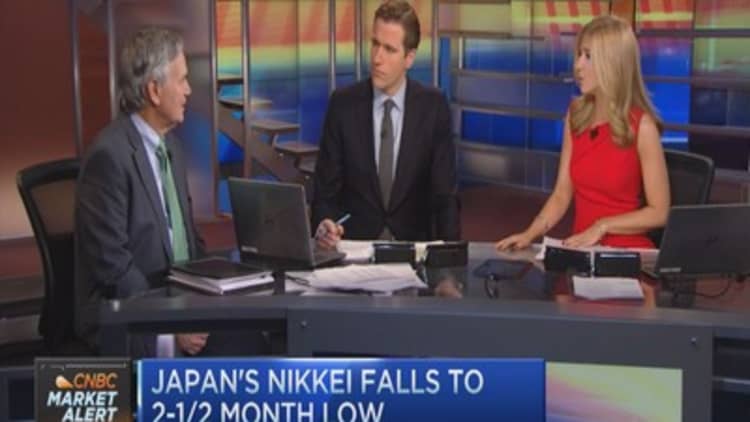China's central bank guided the yuan lower on Thursday at the fastest pace since its shock devaluation in August, prompting a shuttering of mainland stocks and roiling markets elsewhere.
The People's Bank of China (PBOC) set the yuan reference rate at 6.5646 against the dollar, down 0.51 percent from Wednesday's fix, and the lowest mid-point since 2011. That represents the largest daily change in the fix since August 13, according to Reuters data. The yuan had finished at 6.5554 on Wednesday.
China's central bank lets the yuan spot rate rise or fall a maximum of 2 percent against the dollar, relative to the official fixing rate.
The currency moves have revived a litany of concerns in financial markets, from the health of the Chinese economy that is growing at its slowest pace since the financial crisis to the impact of a weaker yuan on capital outflows, which have accelerated in recent months.
The more stocks fall on cues from a lower yuan, the more investors may be encouraged to yank funds out of China and park them overseas, in turn exerting further pressure on the yuan.
"The PBOC said the fix will be based on the previous day's close and a softer fix is therefore not inconsistent with market forces," said Vishnu Varathan, head of economics and markets strategy at Mizuho Bank's Singapore office.
"There is a sense in the market that the offshore market is getting carried away though and the PBOC would want to rein in excessively aggressive one-way bets," he said.
Thursday's fix jolted markets, with the more freely-traded offshore yuan plunging to a record low of 6.7511 against the dollar before recovering to 6.6910 on suspected intervention. The onshore yuan rate fell to as much as 6.5941, a five-year low and was at 6.5920 in late trading.
Emerging market currencies also dived, with analysts expecting China's export rivals to let their currencies weaken to maintain competitiveness. The malaise wasn't restricted to just developing countries either. Australia, a big beneficiary of Chinese demand for commodities, also saw a fall in its currency.
Equity markets in the region tumbled, with Chinese stocks closing for the day after the CSI 300 index fell more than 7 percent, triggering a circuit breaker.
Economists believe that Thursday's fix largely reflects the willingness of the central bank to establish a more flexible exchange rate regime, although there are also benefits from a weaker currency.
"From a macroeconomic perspective, a weaker exchange rate is also consistent with monetary policy easing," ANZ economists Li-Gang Liu and Raymond Yeung said in a research note.
"A weaker exchange rate can help induce some import inflation as the down trend of crude prices intensifies. China is the largest net oil importer," they said.

Given some of the drivers of the yuan's weakness—strong capital outflows as well as strength in the dollar, which has gained following an interest rate increase from the U.S. Federal Reserve—are still play, the currency looks poised for further falls, although the PBOC is expected to cushion the drop.
"The PBOC is unlikely to allow uncontrolled yuan depreciation and they have the firepower to manage the pace and magnitude of weakness, but it is clear that a more flexible and market determined exchange rate regime is quickly evolving," said Jason Daw, head of Asian foreign exchange strategy at Societe Generale.
Daw expects the onshore dollar-yuan rate to reach 6.80 by the final quarter of 2016.


